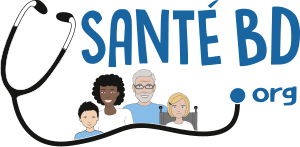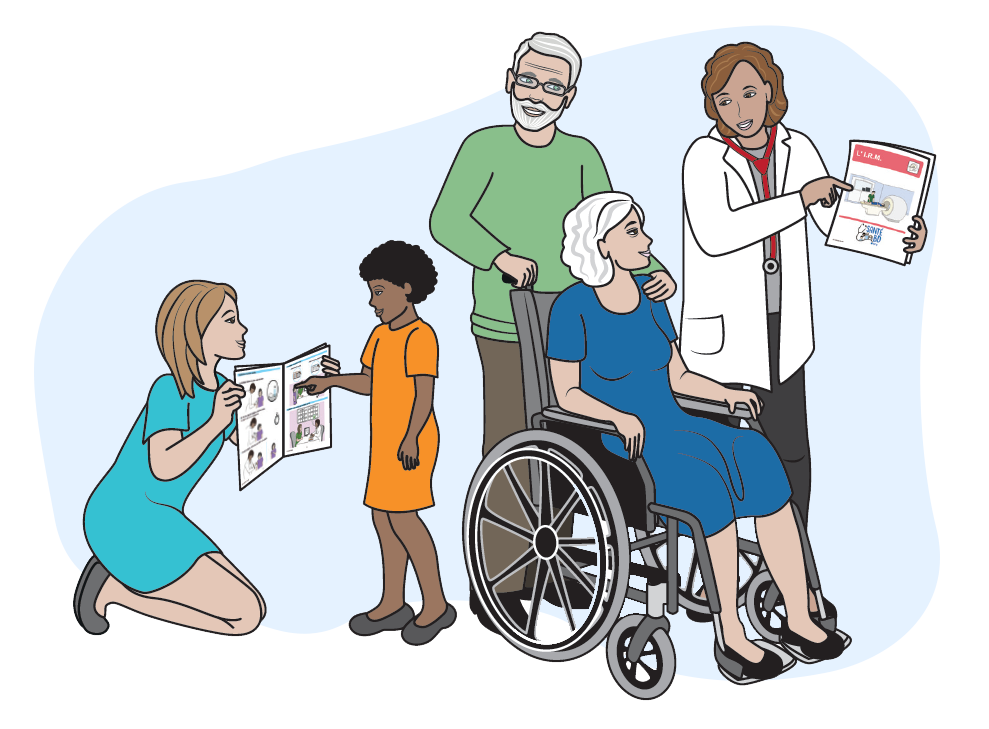Transcription textuelle de la BD A mammogram
What is it for ?
A mammogram is an x-ray of your breasts.
A mammogram lets you see if you have a tumour in your breasts.
A tumour is a sort of lump.
Some tumours are not serious.
Some tumours are serious like cancer.
A mammogram lets me see if I have cancer.
If the cancer is detected early, my treatment is easier.
If the can is detected later, my treatment is more difficult.
When do I need a mammogram ?
If I am over 50 years old and I receive an invitation for regular screening,
or if my doctor gave me a prescription.
If I am over 50 years old: I receive an invitation for a mammogram.
This invitation offers me a mammogram completely free of charge.
After I am over 50 years old, I receive an appointment every two years.
The doctor gives me a prescription for a mammogram.
If I feel something unusual when I squeeze my breast like a lump or liquid that leaks.
See the « Self-examination » fact-sheet
If my doctor notices something abnormal in my breasts.
See our fact-sheet « Gynaecology » breast examination.
My doctor may tell me to have a mammogram.
They write me a prescription.
What happens?
The day before my mammogram I must not use:
- Body cream,
- powder.
I can have a mammogram:
- At a radiology centre,
- or in a clinic or hospital.
I bring the pictures from my last mammogram.
- with the letter I received,
- with the prescription from my doctor.
The radiographer meets me.
The radiographer is the person who operated the X-Ray machine.
- I can come on my own,
- or somebody can accompany me.
The radiographer asks me:
If anybody in my family has had problems with their breasts?
If I am pregnant?
I go into the X-Ray room.
There are:
- a booth for the radiographer and the radiologist
- an X-Ray machine with a tube, a plate that moves and a plate to position my breast.
- a changing room
The technician explains what is going to happen.
The person who accompanies me can stay with me.
The radiographer gives them clothes like a protective apron.
For example: a protective apron
I go into the changing room.
I take off my jewellery.
I undress my top half.
I stand facing the machine.
I hold the bar.
The radiographer places my breast on the plate on the machine.
The radiographer presses my breast between the two plates.
It may be uncomfortable, but it is very quick.
I count to 10.
The radiographer positions the tube to take the X-Ray.
The radiographer asks me:
- not to move.
- to hold my breath. I breathe in deep. I must not breathe out.
The X-Ray is done. The plate is released.
I can let go of the bar.
I can breathe normally again.
The radiographer takes another X-Ray of my breast.
This second X-Ray is done exactly like the first one.
They move the machine: it is at an angle.
I stand to one side and hold the bar.
The radiographer places my breast on the plate on the machine.
The radiographer presses my breast between the two plates.
It may be uncomfortable, but it is very quick.
I count to 10.
The radiographer positions the tube to take the X-Ray.
The radiographer asks me:
- not to move.
- to hold my breath. I breathe in deep. I must not breathe out.
The X-ray is done. The plate is released.
I can let go of the bar.
I can breathe normally again.
The radiographer does the same thing for my other breast.
After the mammogram
I can put on my top while I wait for the radiologist.
I don’t put my bra on yet.
The radiographer prints the mammogram.
The radiographer comes to talk to me about what they can see on the X-Ray.
The radiologist is the doctor who analyses the mammogram.
The radiologist may:
- examine my breasts with their hands: this means touching my breasts.
- examine my breasts with a machine: this is an ultrasound scan. The doctor sees the inside of my breasts on the screen.
When it is all finished, I can get dressed and put my jewellery on.
If I am over 50 years old and I received a letter:
I get my mammogram and my results later by post.
If I had a mammogram with a prescription.
I come back to get my results and a letter for my doctor.
I go to see my doctor with my mammogram.
He explains my results and answers my questions.
I may recommend more tests.
Part of the project « Prevention and Detection of breast and colorectal cancers for disabled people », this fact-sheet was co-designed in partnership with
- l’Adapei de l’Ain
- l’Adapei Ardèche
- l’Adapei de la Drôme
- l’Afiph (association familiale de l’Isère pour personnes handicapées)
- l’Adapei Loire
- la fondation OVE
- l’APF
- l’Adapei 69
- l’Udapei Savoie
- l’Udapei Haute-Savoie
It was financed by the Auvergne-Rhône-Alpes regional health agency.
This fact-sheet was approved by the French national council of gynaecological and obstetric medicine.
SantéBD Multilingual is a project supported by the Orange Foundation.
SantéBD booklets?
- On the internet: Visit the website: www.santebd.org
- On the SantéBD Channel Youtube
SantéBD booklets are free.
SantéBD is a project by the NGO Coactis Santé contact@santebd.org
SantéBD booklets are produced in partnership with different participants from the world of healthcare and working with disabilities. Illustrations by Frédérique Mercier.
Copyright Coactis Santé
The creation of this tool was made possible with the support of:
- la Fondation Handicap Malakoff Humanis
- la Fondation de France
- la mairie de Paris
- l’Assurance maladie
- la Caisse nationale de solidarité pour l’autonomie
- Santé publique France
This document was proofread by people with learning disabilities and respects the European Easy-to-Read Guidelines. These guidelines help to make information available for everyone.
For more information visit the website https://www.inclusion-europe.eu/easy-to-read/





